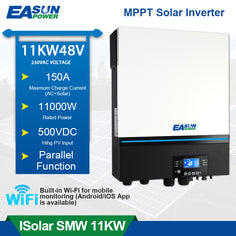In the realm of renewable energy, the solar inverter with maximum power point tracking (MPPT) stands out as a pivotal technology. This innovation ensures that solar energy systems operate at their highest efficiency, maximizing the energy harvested from solar panels. But what exactly is MPPT, and why is it so crucial for solar inverters?

Understanding Maximum Power Point Tracking (MPPT)
Maximum Power Point Tracking (MPPT) is a technique used in solar inverters to optimize the power output from photovoltaic (PV) panels. Solar panels have a non-linear output efficiency, which means their power output varies with sunlight intensity, temperature, and other factors. MPPT technology continuously monitors these variables to ensure that the solar panels operate at their optimal power point.
MPPT technology can increase the efficiency of a solar power system by up to 30% compared to systems without MPPT.
How Does MPPT Work?
MPPT works by adjusting the electrical operating point of the modules or array. It uses algorithms to find the point at which the solar panels produce the maximum power. This point is known as the Maximum Power Point (MPP). By constantly tracking this point, the inverter can adjust the load on the solar panels to ensure they are always operating at their peak efficiency.
Key Benefits of MPPT Technology
- Increased Efficiency: MPPT ensures that solar panels operate at their maximum efficiency, leading to higher energy output.
- Better Performance in Varying Conditions: MPPT can adapt to changes in sunlight and temperature, maintaining optimal performance.
- Enhanced System Lifespan: By optimizing the power output, MPPT reduces the stress on the solar panels and other system components, potentially extending their lifespan.
Applications of MPPT in Solar Inverters
Solar inverters with MPPT are used in various applications, from residential solar power systems to large-scale commercial solar farms. They are particularly beneficial in environments where sunlight conditions can vary significantly throughout the day. For instance, in regions with frequent cloud cover or shading from nearby structures, MPPT can significantly improve the overall energy yield.
Real-World Example: The SolarEdge HD-Wave Inverter
One notable example of a solar inverter with MPPT technology is the SolarEdge HD-Wave Inverter. This inverter is designed to maximize energy production while reducing the cost of energy. It features advanced MPPT algorithms that ensure optimal power output even in challenging conditions.

Conclusion
In conclusion, the solar inverter with maximum power point tracking is an essential component for any solar power system aiming for optimal energy efficiency. By continuously adjusting to the optimal power point, MPPT technology ensures that solar panels deliver the highest possible energy output. Whether for residential or commercial applications, investing in a solar inverter with MPPT can lead to significant long-term benefits, including increased energy production and extended system lifespan.
For more information on solar inverters and MPPT technology, check out this informative video:
